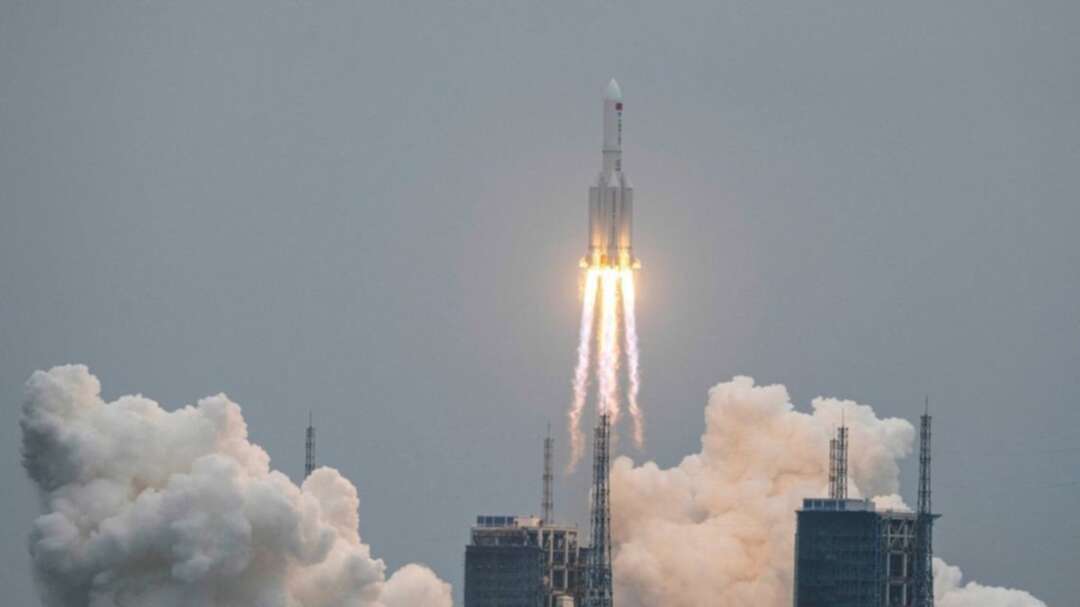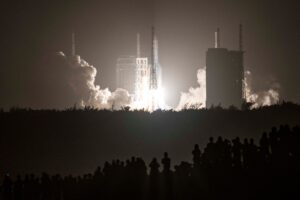-
China space rocket debris set to re-enter Earth: US, R&D center

Remnants of China’s largest rocket launched last week are expected to plunge back through the atmosphere late Saturday or early Sunday, a US federally funded space-focused research and development center said.
China’s foreign ministry said on Friday that most debris from the rocket will be burned up on re-entry and is highly unlikely to cause any harm, after the US military said that what it called an uncontrolled re-entry was being tracked by US Space Command.In a tweet sent on Friday evening in the United States, the Aerospace Corporation said that the latest prediction for the re-entry of the Long March 5B rocket body by its Center for Orbital Reentry and Debris Studies (CORDS) was for eight hours on either side of 0419 GMT on Sunday.
https://twitter.com/AerospaceCorp/status/1390800736271814656
CORDS’ latest “informed prediction” of the rocket body’s re-entry location was given near the North Island of New Zealand, but it noted that re-entry was possible anywhere along paths covering large swathes of the globe.
The Long March 5B - comprising one core stage and four boosters - lifted off from China’s Hainan island on April 29 with the unmanned Tianhe module, which contains what will become living quarters on a permanent Chinese space station.
The Long March 5 family of rockets have been integral to China’s near-term space ambitions - from the delivery of modules and crew of its planned space station to launches of exploratory probes to the moon and even Mars.
The Long March launched last week was the second deployment of the 5B variant since its maiden flight in May last year.
Harvard-based astrophysicist Jonathan McDowell previously told Reuters there is a chance that pieces of the rocket could come down over land, perhaps in a populated area, as in May 2020, when pieces from the first Long March 5B rained down on the Ivory Coast, damaging several buildings, though no injuries were reported.
Debris from Chinese rocket launches is not uncommon within China. In late April, authorities in the city of Shiyan, Hubei province, issued a notice to people in the surrounding county to prepare for evacuation as parts were expected to land in the area.
“The Long March 5B re-entry is unusual because during launch, the first stage of the rocket reached orbital velocity instead of falling downrange as is common practice,” the Aerospace Corporation said in a blog post.
“The empty rocket body is now in an elliptical orbit around Earth where it is being dragged toward an uncontrolled reentry.”
 In this file photo a Long March 5B rocket carrying China's Chang'e-5 lunar probe launches from the Wenchang Space Center on China's southern Hainan Island on November 24, 2020, on a mission to bring back lunar rocks, the first attempt by any nation to retrieve samples from the moon in four decades. (File photo: AFP)
In this file photo a Long March 5B rocket carrying China's Chang'e-5 lunar probe launches from the Wenchang Space Center on China's southern Hainan Island on November 24, 2020, on a mission to bring back lunar rocks, the first attempt by any nation to retrieve samples from the moon in four decades. (File photo: AFP)The empty core stage has been losing altitude since last week, but the speed of its orbital decay remains uncertain due to unpredictable atmospheric variables.
It is one of the largest space debris to re-enter Earth, at 18 tonnes.
The core stage of the first Long March 5B that returned to Earth last year weighed nearly 20 tonnes, surpassed only by debris from the Columbia space shuttle in 2003, the Soviet Union’s Salyut 7 space station in 1991, and NASA’s Skylab in 1979.
source: Reuters
Image source: AFP
Levant
You May Also Like
Popular Posts
Caricature
BENEFIT Sponsors BuildHer...
- April 23, 2025
BENEFIT, the Kingdom’s innovator and leading company in Fintech and electronic financial transactions service, has sponsored the BuildHer CityHack 2025 Hackathon, a two-day event spearheaded by the College of Engineering and Technology at the Royal University for Women (RUW).
Aimed at secondary school students, the event brought together a distinguished group of academic professionals and technology experts to mentor and inspire young participants.
More than 100 high school students from across the Kingdom of Bahrain took part in the hackathon, which featured an intensive programme of training workshops and hands-on sessions. These activities were tailored to enhance participants’ critical thinking, collaborative problem-solving, and team-building capabilities, while also encouraging the development of practical and sustainable solutions to contemporary challenges using modern technological tools.
BENEFIT’s Chief Executive Mr. Abdulwahed AlJanahi, commented: “Our support for this educational hackathon reflects our long-term strategic vision to nurture the talents of emerging national youth and empower the next generation of accomplished female leaders in technology. By fostering creativity and innovation, we aim to contribute meaningfully to Bahrain’s comprehensive development goals and align with the aspirations outlined in the Kingdom’s Vision 2030—an ambition in which BENEFIT plays a central role.”
Professor Riyadh Yousif Hamzah, President of the Royal University for Women, commented: “This initiative reflects our commitment to advancing women in STEM fields. We're cultivating a generation of creative, solution-driven female leaders who will drive national development. Our partnership with BENEFIT exemplifies the powerful synergy between academia and private sector in supporting educational innovation.”
Hanan Abdulla Hasan, Senior Manager, PR & Communication at BENEFIT, said: “We are honoured to collaborate with RUW in supporting this remarkable technology-focused event. It highlights our commitment to social responsibility, and our ongoing efforts to enhance the digital and innovation capabilities of young Bahraini women and foster their ability to harness technological tools in the service of a smarter, more sustainable future.”
For his part, Dr. Humam ElAgha, Acting Dean of the College of Engineering and Technology at the University, said: “BuildHer CityHack 2025 embodies our hands-on approach to education. By tackling real-world problems through creative thinking and sustainable solutions, we're preparing women to thrive in the knowledge economy – a cornerstone of the University's vision.”
opinion
Report
ads
Newsletter
Subscribe to our mailing list to get the new updates!






















